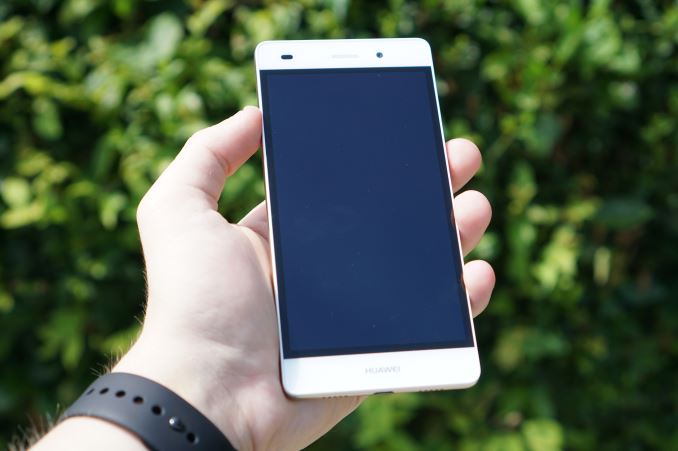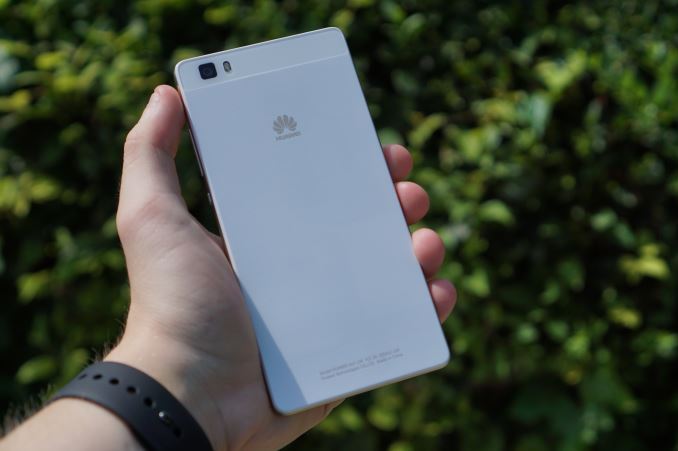The Huawei P8 Lite Review
by Brandon Chester on July 27, 2015 8:00 AM EST- Posted in
- Smartphones
- Huawei
- Mobile
Final Words
Mid range devices in the $200-300 range are more interesting than devices at the low end of the smartphone market because there's more room for OEMs to prioritize some features over others in order to differentiate their device. With low end devices it's often the same story of a Snapdragon 400/410 SoC with 1GB of RAM, 8GB of NAND, a 5MP or possibly an 8MP camera, and a qHD display. In the mid range market OEMs can choose to spend more money on certain areas to improve the experience, whether that be a faster SoC, a better display, better build quality, or better cameras. The P8 Lite represent's Huawei's view on what features are most important in a mid range device.
Build quality is definitely an area of focus on the P8 Lite. The chassis feels sturdy, and it feels fairly good in the hand. At 7.7mm thick it's also much thinner than many other low end and mid range devices, although this results in a compromise on battery capacity. As for the design side of things, I'm personally not the biggest fan due to the metal band around the edges. While I don't know how many people will share this view, I'm disappointed that a single design element ends up ruining the appearance of the phone for me.
The 5.0" 1280x720 display on the P8 Lite is definitely one of its weaker aspects. The calibration is just not near as good as it should be, especially with devices in the sub-$200 bracket becoming very accurate. At 5" the 720p resolution has decent sharpness, but I find myself longing for the 5.5" 1080p panel on the Zenfone 2 which is only $199. Since the display is something you look at all day, Huawei really needs to improve in this area by eliminating the blue shift in the greyscale and improving general color accuracy.
As for performance, Snapdragon 615 is really the best you're going to get at this price point unless you go with the Zenfone 2 which is something of an anomaly in many ways. Huawei is using the bin with the big cluster of A53 cores clocking up to 1.5GHz rather than 1.7GHz like in the HTC One M8s, but it still has significant performance improvements over Snapdragon 400 and 410 in low end devices. There would be even greater gains on the CPU side if it was operating in AArch64 mode, but with the P8 Lite shipping with KitKat it's forced to operate in AArch32 mode. I really don't feel it's acceptable to be shipping any devices with KitKat this late into 2015, as it has performance issues and uses Android's older Dalvik runtime.
The GPU shows even more substantial improvements than the CPU, with performance being anywhere from 1.5x to 3x faster than Adreno 305/306. As far as memory goes, the additional gigabyte of RAM also helps to keep things running smoothly, but NAND quality is definitely an area Huawei needs to continue to improve on. Both random and sequential reads and writes are as slow or slower than the Moto E which at times sells for less than half the price of the P8 Lite. It's hard to say how much of an impact this will have with the workload of a typical P8 Lite buyer, but there's certainly no reason not to improve on areas where devices fall short.
The 13MP rear-facing camera is where the P8 Lite really shines. Shots that aren't taken in the middle of the night end up being better than any other device I've seen at this price point. Much of this is owed to the well balanced processing that Huawei applies to images. Once you get into extreme low light there tends to be a dramatic loss of detail due to excessive noise reduction, and I think image quality would be substantially improved if Huawei would tone it down a few notches when taking photos in the dark.
The quality of videos recorded on the P8 ends up falling short compared to the still image quality. Even with a fairly high bitrate for 1080p video, there's just an overall lack of detail in every frame. Fixed focus also means that there's often blurriness when pointing the camera to new areas, and Huawei needs to work out whatever issues are occurring with the right channel audio recording.
The last important aspect to cover is battery life, and unfortunately this is where the P8 Lite really let me down. The P8 Lite's battery life is unimpressive in our web browsing benchmark, and the very short time in PCMark's battery test just confirms something I continually noticed when using the phone which is that the battery life is too short during general use. This problem is made worse by a very long charge time, which means that the phone dies quickly and takes a long time to be back up and running. Since the P8 Lite doesn't deliver on battery life, I don't know why users wouldn't instead purchase something like the ASUS Zenfone 2 unless they really want the P8's camera quality or smaller size.
Ultimately, there are no bad phones, just bad prices. The P8 Lite wouldn't be a bad recommendation if it was priced a bit lower and received an update to Lollipop. While I don't know if it would be possible for Huawei to reach a price of $150, I would need the P8 Lite to be priced somewhere below $200 before I could really recommend it. At this time there are simply better options in the $200-300 range, and so at its current price point the P8 Lite is a phone I find difficult to recommend.












45 Comments
View All Comments
Buk Lau - Wednesday, July 29, 2015 - link
It is capable of QC 2.0, they just don't ship you with a charger and you just have to get it yourself from somewherezebrax2 - Monday, July 27, 2015 - link
Error in the specifications table showing A7 instead of A53.jjj - Monday, July 27, 2015 - link
Disturbing that for a SoC known for it's overheating capabilities (yes this one too), you fully ignore the issue and don't look for throttling."Snapdragon 615 is really the best you're going to get at this price point"
That is clearly a false statement and not sure how can you make it. SD615 is likely the worst A53 based solution in this price range clock for clock and not just in CPU. If you factor in that others are going higher clocks (without overheating) in the same price band and even higher clocks for slightly costlier and more capable SoCs , your statement becomes even more absurd.
But that's when you factor in the SoC price not the device price. If you go by device price, the OnePlus One is 250$ and if you factor in China, a bunch of faster devices are at or very close that price.
T1beriu - Monday, July 27, 2015 - link
Source?jjj - Monday, July 27, 2015 - link
For what? SD615 can't do 1.7GHz and pretty much any device with those clocks is know to have problems. At 1.5GHz it throttles little if at all but that can depend on the device and requires investigation. As for how it does against competing 8xA53 SoCs from Hisilicon (hey those are actually worse), Marvell, Mediatek and Samsung it would take some time(that i don't have) to find a bunch of reasonably good links since too many can't be bothered to look beyond Qualcomm, just like AT loves to do.djw39 - Monday, July 27, 2015 - link
How can you say the Snapdragon 615 is "likely the worst A53 based solution in this price range" then?LiverpoolFC5903 - Tuesday, July 28, 2015 - link
The MTK 6752 is significantly faster than the SD 615 and runs cooler too, despite all the ores being clocked at a relatively high 1.7ghzThe 615 flatters to deceive and is hamstrung by memory bandwith issues and thermals. If they had provided a dual channel 32 bit RAM like the older Snapdragon 600 and paired it with the Adreno 320, it would have been a killer mid range chip. Alas,this is par for the course these days with Qualcom chipsets.
One more observation, the Zenfone 2 is absolutely suberb in terms of performance/price/ Nothing else in the midrange comes close to it in terms of both CPU and GPU performance. The 2.3 GHZ and 4 GB model at 300 USD performs as good as any Snapdragon 801 device and trades blows with the 805.
AndrewJacksonZA - Tuesday, July 28, 2015 - link
Totally off topic, so apologies in advance, but..."T1beriu" as your nick? Is it meant to be in reference to the Tiber River? Tiberius Caesar? Tiberium? Brigadier General Mark Jamison Sheppard must know! :-)
twizzlebizzle22 - Monday, July 27, 2015 - link
What's the benefit of using big little with the same core architecture between the clusters.Can't one cluster scale back under lighter workloads?
cmikeh2 - Monday, July 27, 2015 - link
You can fab the transistors for the two different clusters differently. For the high performance cluster, you would use a higher leakage, faster transistor (and power gate when not in use) and for the low power cluster use slower, but lower leakage transistors.